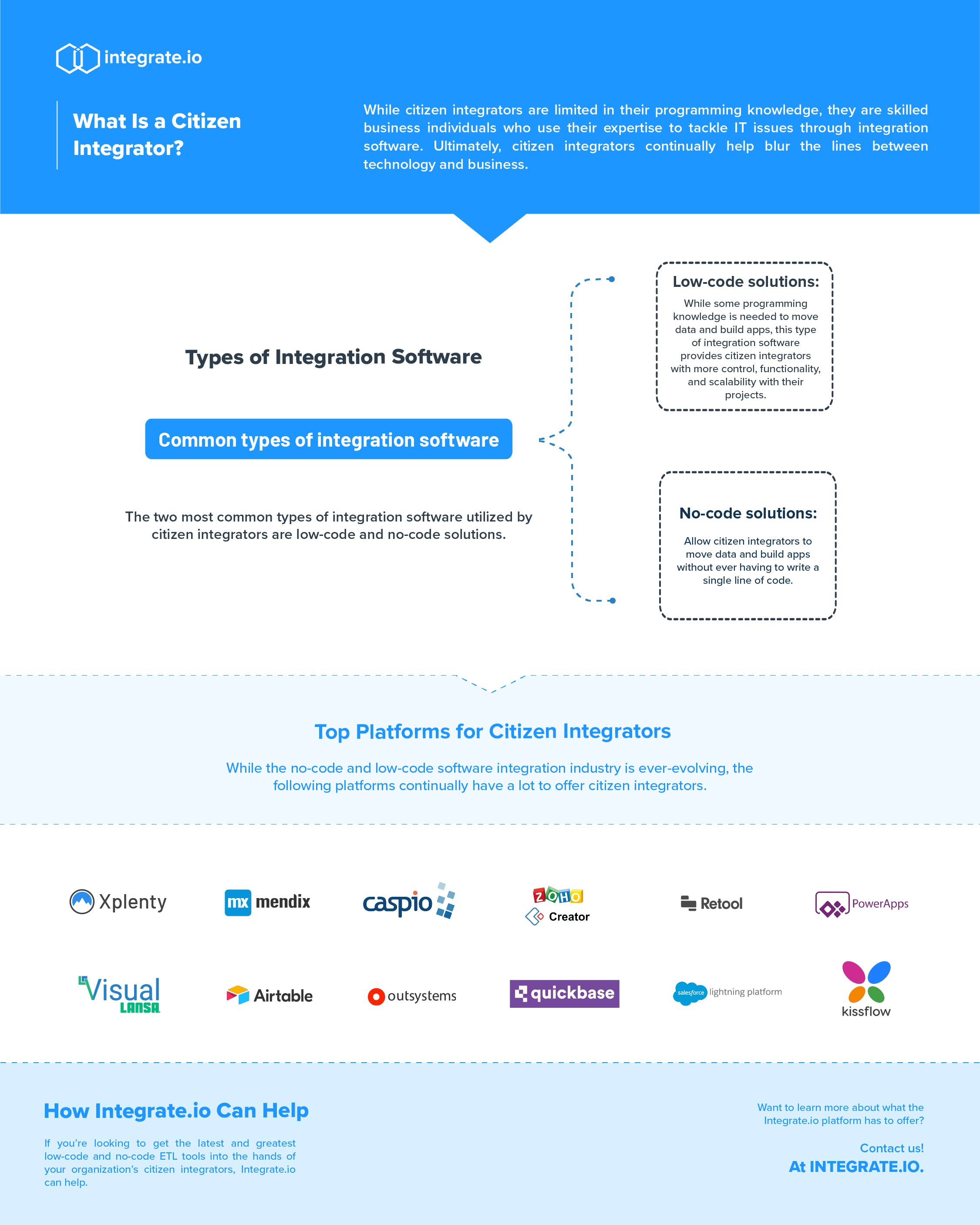In the ever-changing world of technology, the tools available to citizen integrators are constantly evolving as well. For citizen integrators, access to better low-code integration tools certainly makes their job much easier. However, with the industry landscape constantly changing, it can be difficult to keep up with all the latest trends and find the right low-code integration tools to best meet the needs of the company.
Read on to learn more about citizen integrators and to discover more about the current industry landscape as it relates to commonly utilized low-code integration software.
What Is a Citizen Integrator?
Essentially, citizen integrators are valuable members of organizations helping to blur the lines between technology and business. Citizen integrators are typically not developers and have little to no programming experience. However, while citizen integrators generally have limited IT knowledge, they are often highly qualified in some business-related processes.
Ultimately, a citizen integrator’s expertise in a business-related process, along with their willingness to learn more about the needs of users and learn basic IT processes, is what allows them to utilize low-code integrations and connect applications and data. Read on to learn more about the common types of integration software citizen integrators use.
Related Reading: The Role of the Empowered Citizen Integrator in Democratizing Technology Across the Enterprise
Types of Integration Software
In the current industry landscape, the two most common types of integration software that citizen integrators use are low-code and no-code tools. As more business professionals have taken an interest in handling some of their own tech needs over the last several years, the no-code and low-code movement has exploded. Check out more about these two types of integration software below.
No-Code Tools
As it stands, many small to medium-sized companies without access to a data engineering team often utilize no-code integration tools and software. The great thing about no-code tools is that anyone within an organization can use them to make apps and transfer data without having to have any coding knowledge at all.
Low-Code Tools
In comparison to no-code tools, low-code tools are preferred by citizen integrators who have at least a basic understanding of hand-coding. If citizen integrators are willing to put in a little more effort, low-code software proves beneficial, as it provides more control, functionality, and scalability compared to no-code software.
Now that we’ve outlined the most common types of integration software utilized by citizen integrators in the current industry, it’s time to check out some of the top vendor offerings in the market today.
Related Reading: Low-Code vs. No-Code: The Real Difference
Top Platforms for Citizen Integrators
While the software integration industry is ever-evolving, the following platforms reign supreme when it comes to providing citizen integrators with the latest and greatest low-code and no-code software.
- Integrate.io – A low-code and no-code ETL data integration platform that is useful for building data pipelines to and from over 100 data sources and destinations.
- Mendix – A cloud-native Rapid App Development (RAD) platform that promises to deliver apps up to 10x faster than hand-coding.
- Quickbase – A top-ranked low-code platform that is a widely used cloud-based RAD platform and database software.
- Visual LANSA – A low-code development platform that allows users to deploy new apps in just a few days.
- Retool – Its drag-and-drop feature allows users to build internal tools fast.
- Airtable – A low-code platform that allows for the building of collaborative apps.
- Microsoft Power Apps – A reliable low-code RAD platform powered by Microsoft.
- Zoho Creator – A trusted low-code application platform that allows users to create custom applications with minimal coding experience.
- Salesforce Lightning – A platform that contains all the power of Salesforce but also possesses low-code app development.
- Caspio – A low-code and no-code platform that allows users to build cloud database apps without coding.
- OutSystems – A RAD platform useful for developers to create and manage their applications.
- Kissflow – A top recognized g2.com leader among digital workforce software that offers an easy-to-use drag-and-drop interface for rapid app development.
Overall, these are the top vendor offerings when it comes to providing easy-to-use low-code and no-code tools to citizen integrators. There are a lot of great options on this list, and choosing the right platform will ultimately come down to the needs and goals of your organization.
Related Reading: The Top 5 Benefits of Low-Code Development Platforms
How Integrate.io Can Help
If you’re looking to bring the best low-code or no-code software the industry has to offer into your company, Integrate.io is here to help. With Integrate.io, your organization’s citizen integrators will finally be able to get the most out of company data without ever having to write a single line of code.
Are you ready to see what benefits the Integrate.io platform and its low-code and no-code ETL tools can provide to your company? Contact our team today to schedule a 7-day demo or pilot and see how we can help you reach your goals.











